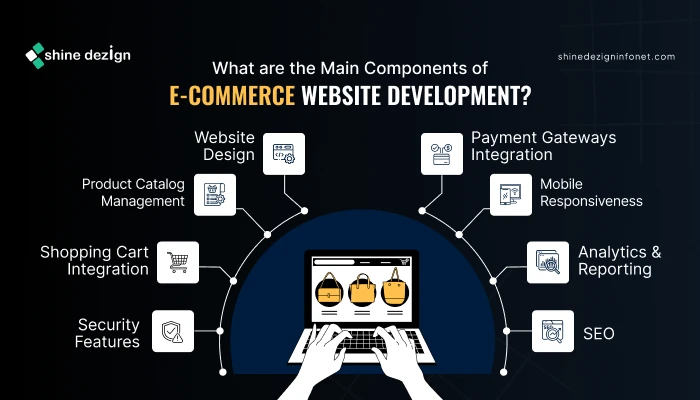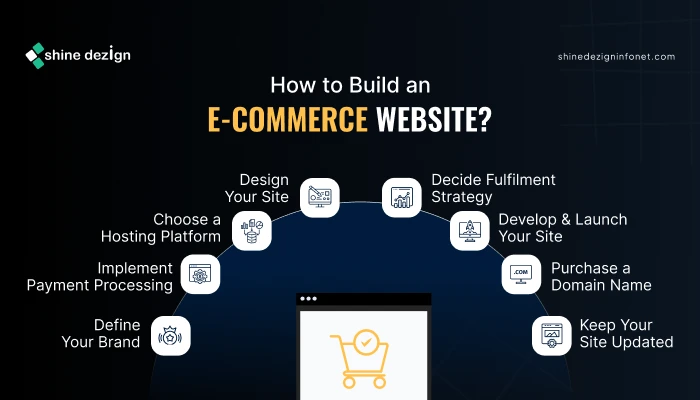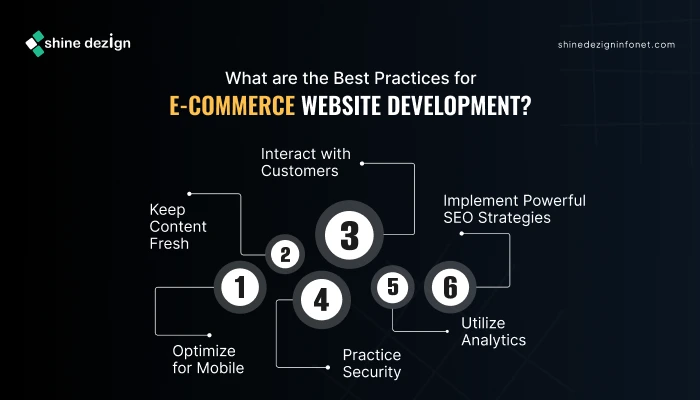Table of Contents
- Introduction
- What is E-Commerce Website Development?
- What are the Main Components of E-Commerce Website Development?
- Why Create an E-Commerce Website?
- How to Build an E-Commerce Website?
- How Much Does It Cost to Create an E-Commerce Website?
- What are the Best Practices for E-Commerce Website Development?
- Summing Up
E-commerce has emerged as an essential component of modern retailing. Since individuals increasingly shop online, companies must embrace this change by investing in e-commerce website development.
Through this blog, we will explain how to develop an E-commerce website, its meaning, why you should develop one, how to develop a custom e-commerce website, the cost involved, and best practices for success.
What is E-Commerce Website Development?
The E-commerce website development process describes the practice of designing and developing an online portal for consumers or users to buy and sell products and services seamlessly. In simpler words, the E-commerce website development process is utilized to describe the practice of designing & developing an online portal for consumers or users to buy and sell products & services seamlessly.
This includes a wide range of activities like determining the target audience, market requirement, creating intuitive designs, adding essential functionality to make the shopping process easy for customers, and to increase user retention and sales.
What are the Main Components of E-Commerce Website Development?

The main components of E-commerce website development are:
Website Design:
The website’s appearance and interface are key in drawing and holding customers. It must be visually appealing, simple, and aligned with the brand identity.
Product Catalog Management:
Organizing and listing products to be simple to browse through is involved. Proper product classification, good images, and accurate descriptions are crucial.
Shopping Cart Integration:
A shopping cart enables the visitor to add products to the cart. It must be easy to use and smoothly transition from product choice to checkout.
Payment Gateways Integration:
It is an important feature that enables secure online payment. The most common payment gateways are PayPal, Stripe, and Square, which will allow credit card and other forms of online payment.
Security Features:
Customer data protection is critical. Building trust requires using SSL certificates, conducting secure transactions, and complying with regulatory requirements such as GDPR.
Search Engine Optimisation (SEO):
Search engine optimization (SEO) must attract organic traffic to e-commerce websites. This includes keyword analysis, on-page SEO, and link building.
Mobile Responsiveness:
With most online shopping happening on mobile, a mobile-responsive site is crucial for providing a seamless user experience.
Analytics & Reporting:
Companies can track user actions, sales performance, and more by integrating tools like Google Analytics. This can help them make data-driven, informed decisions and develop strategies to increase user retention.
Why Create an E-Commerce Website?
Significantly leads to the success of a business. Some of the most convincing arguments for investing in custom E-commerce website development are as follows:
Wider Reach:
An e-commerce website allows small businesses to reach customers worldwide, going beyond the geographical limits that bound physical stores. This broader reach can lead to more sales and brand recognition.
24/7 Availability:
Unlike physical retail stores, online websites are open twenty-four hours a day. Consequently, customers can make their purchases at any time they desire, resulting in high customer satisfaction and conversion rates.
Cost-Effectiveness:
Having an online business for less money than a physical shop is possible. Companies can avoid paying rent, electricity, and labour costs, thereby spending the money on advertisement and product creation. This works in favour of small business web design.
Data Insights:
E-commerce websites offer valuable data on customers’ behaviour, likes, and buying habits. This data can be used to customize marketing efforts, enhance product offerings, and provide better customer service.
Scalability:
E-commerce websites are easily scalable to handle expanding product lines and customer bases. When demand grows, companies can introduce more offerings without physical space limitations.
Better Customer Experience:
With ease of use, customer reviews, and personal recommendations, shopping on e-commerce websites can be a superior experience than doing business offline.
Marketing Opportunities:
Numerous digital marketing campaigns, such as search engine, social media, and email, can generate traffic and sales for an e-commerce website.
How to Build an E-Commerce Website?
 Small business website development has some basic steps to keep in mind. This is a formal process to take you through:
Small business website development has some basic steps to keep in mind. This is a formal process to take you through:
1. Define Your Brand:
The first step for developing an e-commerce site is to define your brand, and for that, you have to keep the following points in consideration:
Find Your Niche:
Decide if your company will be B2B (business-to-business) or B2C (business-to-consumer). Knowing your niche will allow you to tailor your products & marketing strategies.
Target Market:
Research your target market’s demographics, interests, and shopping habits. This data will inform your website layout and product offerings.
Business Name and Branding:
Select a name that is easy to remember and not used by others to represent your brand identity. Create a unified branding strategy, including logos, a colour palette, and a message.
2. Purchase a Domain Name:
Purchasing a Domain name is a necessary step in building a website.
Domain Availability:
Check whether your desired domain name is available through domain registration software.
Buy:
Acquire a domain name that suits your brand and is relevant to your business. Use a “.com” extension since it is popular and trusted by customers.
3. Choose a Hosting Platform:
Choosing a perfect hosting platform is necessary to ensure your site works smoothly on the server.
E-commerce Hosting:
Choose an e-commerce-focused hosting platform. Some of the most used ones are Shopify, WooCommerce (for WordPress), BigCommerce, and Magento. They all have different features, so pick the best for your business.
Pre-built Designs:
Most e-commerce sites have customizable templates, which simplify the design process. Select a template that is perfect for your brand and offers a good user experience.
4. Design Your Site:
Creating an intuitive design is necessary to engage users with the website.
User Experience (UX):
Concentrate on making your website usable and pleasant to look at. Ensure the layout is easy to browse through, with clear categories and simple access to product pages.
Mobile Optimization:
As most shopping is now via mobile, ensure your website is responsive. Test the website on different devices to ensure everyone has an effortless experience.
Visual Elements:
To showcase your products, add high-quality images and videos. For a better presentation, add features such as zoom-in and 360-degree views.
5. Decide Fulfilment Strategy:
Decide on strategies like shipping rates, delivery times, etc., to ensure seamlessness.
In-House vs. Outsourcing:
Decide whether to do it in-house or use third-party logistics companies. In-house is more controlled, but outsourcing can be cost- and time-effective.
Shipping Options:
Determine shipping rates and delivery times precisely. To accommodate different customer needs, offer several shipping options, including standard, expedited, and international shipping.
6. Develop & Launch Your Site:
After this, focus on developing and launching your website.
Website Builders:
Utilize e-commerce website builders like Shopify for a user-friendly experience. These platforms often provide drag-and-drop functionality, making it easy to customize your site without extensive coding knowledge.
Testing:
Before launching, thoroughly test all features, including payment processing, site speed, and mobile responsiveness. Conduct user testing to gather feedback and make necessary adjustments.
7. Implement Payment Processing:
Integrate the secure payment processing gateways for a smooth checkout process.
Payment Gateway Integration:
Select a secure and trustworthy payment gateway that accepts multiple payment options, such as credit cards, digital wallets, and bank transfers. Make the payment process safe and easy to use.
Security Measures:
Use SSL certificates to encrypt data and secure customer information. Update your website and plugins to avoid security attacks.
8. Keep Your Site Updated:
At last, keep your site up to date to keep users engaged.
Regular Updates:
Add new products, offers, and content to your site regularly. Update your product catalog regularly so customers will continue to find it interesting.
Customer Feedback:
Use customer feedback & reviews to enhance your offerings. Use this to make wise choices & refine the user experience.
SEO and Marketing:
Search engines optimize your site regularly. Establish content marketing outlets, like blogs and social networks, to drive traffic and build brand recognition.
How Much Does It Cost to Create an E-Commerce Website?
The E-commerce website development cost can range widely depending on some factors, such as the site’s complexity, features required, and platform, like:
Complexity of Website:
Your web store’s complexity directly increases the cost. A simple site with fewer features (e.g., product lists and shopping cart) will generally be less expensive than a complex site with sophisticated features like custom integration, multiple payment options, and massive product catalogues.
Features Required:
The specific functionalities you want on your e-commerce site will also affect the cost. Typical functionalities that can contribute to the price are:
- Payment Gateway Integration: The number and type of payments you want to accept (credit cards, digital wallets, etc.) can drive costs.
- Inventory Management: More advanced inventory management systems can increase development costs.
- Customer Accounts: Allowing customers to sign up for accounts and store their profiles can add complexity.
- SEO Optimization: Adhering to SEO best practices can also mean additional spending on tools or services.
- Mobile Responsiveness: Getting your site completely mobile-optimized might also add to the cost.
Platform Choice:
The price of the e-commerce platform plays a significant role in determining the final price. Some platforms are less expensive but may charge transaction fees, whereas others may require a higher starting cost but offer more feature-based functionality without ongoing fees. Custom solutions will also be more expensive than utilizing a pre-built platform.
Design & Customization:
Your e-commerce site design will cost differently depending on whether you use a template or a custom design. Custom designs tailored to your brand will be more expensive than pre-made templates, and the required customization level may also affect costs.
Hosting & Domain Registration:
The cost of hosting your online store and domain name registration can vary. Shared hosting tends to be less expensive, but dedicated or cloud hosting is more expensive but offers better performance and security. Domain name registration fees are typically smaller and periodic, but they must be factored into your budget.
Marketing & Advertising:
Marketing and advertising budgets are crucial to driving traffic to your e-commerce site. Costs include search engine advertising, social media promotion, and email marketing campaigns, and they need to be included in your e-commerce strategy.
Ongoing Maintenance and support:
After you have created your e-commerce site, upkeep must be regularly performed to keep it running smoothly. This includes updates, security checks, and technical support. The maintenance cost will depend on how intricate your site is and how much assistance you will require.
What are the Best Practices for E-Commerce Website Development?

To make your e-commerce website successful, keep the following best practices in mind:
1. Prioritize User Experience:
A smooth user experience is required to convert visitors into customers. Make it simple for your visitors to navigate with clean calls to action and a seamless checkout. Test with users to find pain points and fix them accordingly.
2. Optimize for Mobile:
With so many consumers accessing and buying products on mobile platforms, a mobile-responsive design is paramount. Ensure that your website is viewed on various screen sizes and that the mobile interface is as fluid as the desktop interface.
3. Implement Powerful SEO Strategies:
Invest in search engine optimization (SEO) to rank your website higher on search engines. Use the appropriate keywords, optimize product descriptions & develop high-quality content to drive organic traffic. This is especially vital in small business website development, where competition could be intense.
4. Practice Security:
Security is paramount in e-commerce. Implement SSL certificates, payment gateways & regular security audits to safeguard customer data. Establishing great trust with your customers will be the success formula in the long term.
5. Utilize Analytics:
Utilize analytics tools to monitor user behaviour, sales performance & other essential metrics. This information can give you valuable insights into customer likes and dislikes & enable you to make better-informed decisions regarding marketing strategies & product offerings.
6. Interact with Customers:
Engage your audience using email marketing, social media, and customer reviews. Building a base of followers for your brand can build loyalty and result in repeat business.
7. Keep Content Fresh:
Update your site regularly with fresh content, such as product lists, blogs, and special offers. This will benefit search engine optimization and return customers for new goods and information.
Summing Up
E-commerce portal development is a significant investment for businesses looking to thrive online. By understanding the aspects of small business e-commerce website development, the reasons why an online store should be created, and the steps taken in the development process, businesses can effectively navigate the complexities of building an online presence.

















